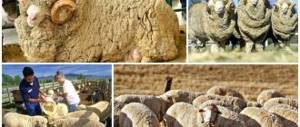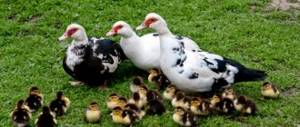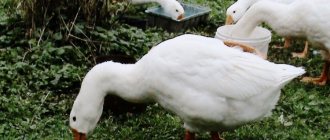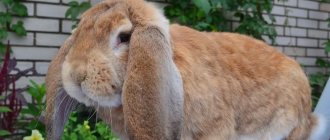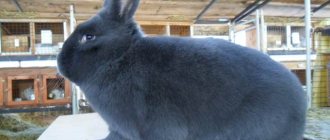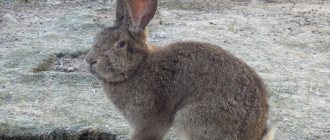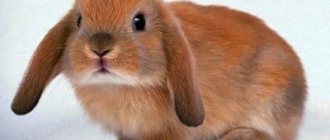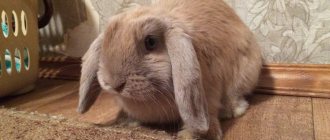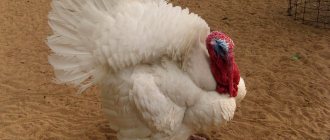The desire of Russians for a healthy lifestyle contributes to the development of the rabbit meat market. Consumers are paying more and more attention to dietary products, and the demand for rabbit meat is constantly growing. In Russia, rabbit breeding is carried out mainly by small farmers, who compete quite successfully with imports of products from China, France or Spain.
Purpose of breeding
Rabbit farming is a profitable branch of livestock farming. With minimal labor and financial costs, large quantities of dietary meat and fur can be obtained in a short time. The main condition for achieving success is a correctly set breeding goal.
These mammals are bred to produce:
- meat;
- fur;
- fluff;
- medical raw materials,
and also for decorative purposes - as a pet.
Most rabbit breeds in Russia are bred exclusively for dietary meat. Regular consumption of rabbit meat helps reduce cholesterol levels and stabilize blood pressure. Animal skins are used to make clothing, and down is used as insulation. Rabbit fat is rich in saturated fatty acids, therefore it is widely used in medicine and cosmetology. Recently, breeding decorative breeds of rabbits has become fashionable. Such pets delight with their appearance and delight not only children, but also adults.
RABBIT, RABBIT BREEDING
Rabbits are mammals of the family of hares of the order Lagomorpha. Breeds of domestic rabbits belong to the common rabbit species. Countries adjacent to the Mediterranean Sea are considered its homeland. Wild rabbits are small, their body length does not exceed 40 cm, and their weight is 2-3 kg. Rabbits began to be domesticated and bred for meat more than 2 thousand years ago.
Nowadays, rabbit breeding is practiced in many countries of the world, including Russia. More than 60 breeds of these early-maturing animals are known, from which skins, meat and fluff are obtained. All breeds of rabbits are divided into fur and down. Fur breeds, in addition, are divided according to the length of the hair into long-haired and short-haired, and according to the nature of the products obtained from them - into skin, meat-skin and meat.
This division is arbitrary, since rabbits of all breeds produce dietary meat and skins - cheap raw materials for industry. The exception is downy rabbits, which are bred for their valuable down.
The most common breeds of rabbits in our country are the Soviet chinchilla, white giant, gray giant, Vienna blue, silver, black-brown, butterfly, Californian, white New Zealand, white downy, etc.
Rabbit breeding as a branch of livestock farming was formed in our country during the years of Soviet power. It began to develop especially quickly in the early 70s, after the party and government adopted special resolutions on the development of this industry.
Rabbit farming is a rapidly developing branch of livestock farming. Today, both specialized state farms and non-specialized farms are engaged in breeding and raising rabbits, in which rabbit breeding has become an additional industry. Rabbit breeding is developing especially intensively on private farms.
Over the course of a year, 40-50 kg of meat is obtained from one female rabbit. Over 5-6 litters per year, the female gives birth to 25-30 young rabbits weighing 50-60 g each, which at 2-3 months of age reach 1.5-2.5 kg.
Currently, rabbit breeding is being gradually transferred to an industrial basis, especially on specialized rabbit breeding state farms. Thus, in the industrial rabbit breeding complex of the Maysky fur farm in the Maikop region of the Kabardino-Balkarian Republic there are 7,000 adult females and 900 males. Here, every year, 170 thousand heads of young animals are raised and 350 tons of rabbit meat are sold to the state. There are 3,000 females in the Koshchakovsky fur farm in Tatarstan. Each of them raises 29 rabbits and produces 65 kg of rabbit meat per year.
A promising industry is down rabbit breeding. In addition to valuable fluff, animals also produce high-quality meat. Fine knitwear, sweaters, jumpers, scarves, socks, etc. are made from rabbit fluff. White down rabbits are bred mainly on the Solntsevsky state farm in the Kursk region and on some collective farms in the Kirov region.
On farms, rabbits are kept in special rooms designed for comprehensive mechanization of all labor-intensive processes. Rabbits are placed in single-tier cages spaced 0.5 m from the floor. In most farms, the rabbits of the main herd are kept in two-tier wooden sheds, and the young animals for fattening are kept in group cages.
The main food for rabbits is grass, root vegetables, concentrates, and hay. The diets of females, as well as young animals up to 4 months of age, should contain 20-25 g of digestible protein. It is necessary for the growth of muscle tissue and coat. Not only the composition of the diet is important, but also how the feed is prepared for feeding. They must be distributed at a strictly defined time.
Rabbit breeding is successfully carried out by young livestock breeders - pioneers and Komsomol members, members of student production teams. Many schools have created rabbit farms and clubs for young rabbit breeders (see Young Animal Breeders).
- Previous: RABBIT
- Next: CALIPER
Which breeds are best to choose?
Depending on the chosen direction of rabbit breeding, there are meat, meat-skin and down breeds of rabbits for breeding.
Meat breeds of rabbits include:
- New Zealand snow white;
- Californian;
- Burgundy;
- gray giant;
- Flanders;
- European silver.
Rabbits of these breeds are distinguished by a calm temperament, high fertility and immunity, low feed consumption and rapid weight gain, and ease of care. From one individual you can get from 4 to 6 kg of meat.
Meat-hide breeds are distinguished by thick, high-quality wool and original color. The most popular breeds in rabbit breeding:
- black-brown;
- butterfly;
- New Zealand;
- Vienna blue;
- snow-white giant.
Downy breeds of rabbits are quite unpretentious in care and tolerate low temperatures well. They can be bred in any region of Russia. With proper care, one rabbit can get from 300 to 500 g of high quality fluff per year.
The most popular breeds for breeding are:
- white Kursk;
- angora.
Breeding and maintenance technologies
Before purchasing animals, you should study the theoretical part of the issue, decide on the choice of breeds and place of keeping. This is a very important point, since rabbits are quite sensitive, susceptible to stress and disease. If they are not satisfied with the conditions of detention, they will not reproduce and may even die.
Rabbit breeding technology provides the following methods:
- Cells.
- Pits.
- Premises with controlled microclimate.
However, regardless of the chosen method, animals must be provided with sufficient feeders, drinking bowls, and high-quality food. The place of detention must be sufficiently lit, equipped with a ventilation system and protected from drafts and bad weather. Compliance with these conditions can increase the productivity of rabbit breeding by 55%. Particular attention should be paid to the microclimate of the housing, since animals breed all year round only under favorable conditions.
Rabbit breeding for beginners recommends breeding animals of medium and small breeds, since they are unpretentious in food and care, and not keeping several breeds at the same time.
In the pits
Pit breeding is most popular in regions with mild climates. Meat breed rabbits are kept in this way. Construction of a pit does not require significant financial costs.
In a hole of 4 square meters. m can accommodate about 200 individuals. The main thing is to properly strengthen the pit so that animals do not make holes, equip it with a ladder and traps. It is also necessary to install a canopy over the pit to protect the rabbits from the rain.
However, this method is not suitable for business because it has a number of disadvantages:
- As the population increases, it is necessary to expand the land area.
- The inability to control fertilization, which ultimately affects profits.
- Decreased sexual activity in the winter season.
- Large consumption of feed, since it will be available to other animals.
- Risk of infections.
- Difficulty in preventive care.
Cellular content
Keeping rabbits in cages is much more expensive, but it makes care easier and allows you to control the process of reproduction and selection. Cells come in different types and sizes. They are installed in heated rooms to maintain an optimal temperature for the reproduction of animals in winter. Cages can also be installed outdoors, but if the temperature drops to -15, the sexual life of the animals is suspended. And in the hot summer, rabbits will be susceptible to diseases, and newborn deaths may also begin.
Single-tiered or multi-tiered cages do not take up much space and are equipped with grooved or bunker feeders, drinking bowls, hay boxes, and a system for cleaning the floors from feces.
Modular sheds
The best option for breeding are modular sheds - closed premises, covered with cellular polycarbonate, with a fan built into the roof. Inside the shed there is a passage along which there are multi-tiered cages on both sides.
This breeding method is combined with artificial insemination, which allows you to produce offspring 7–8 times a year. Males and females are kept in isolated cages.
Industrial cages are equipped with an automatic watering system. Once a week the feeders are filled with food.
Despite the high cost of this breeding method, the costs are recouped quite quickly due to higher productivity, safety of livestock and minimization of manual labor.
Rabbit breeding in modern Russia
The development of rabbit breeding today can be compared with the level of 1907. The country lost most of its individuals due to a viral hemorrhagic disease that came to Russia from China back in 1968. On the one hand, the flow of the sphere does not seem to stand still, but there are no large enterprises involved in breeding rabbits in Russia. As a rule, these are small farms, private enterprises or family businesses that do not strive for development. It is worth saying that some valuable breeds (white downy, gray giant, etc.) bred in the post-revolutionary period are no longer left. Unfortunately, Russia has a small number of farms whose scope of activity is related to purebred breeding of these mammals.
True, the dynamics of animal meat production in the country is positive. This is also indicated by statistics, which say that in 2006, Russian rabbit breeding occupied only 3% of the market, but by the end of 2009 it accounted for 5%, well, 2011 is characterized as one of the positive ones, because domestic products reached 10%. All thanks to small farms that boast high profitability. To support rabbit breeding, subsidies are provided in many districts and regions, and for example, in the Kemerovo region, animals can be obtained for free.
Rabbit breeding technologies
- The very first method that was tested by man was purebred crossing. It is still used today because it is the most predictable.
- If it is necessary to correct certain qualities of the breed, then introductory crossing is used.
- The industrial version of crossing is used mainly in large industries for commercial purposes.
Video lecture from an expert on the development of rabbit breeding
A meaningful lecture recorded on video, which addresses all the main issues of development, starting with private farming.
Feeding
For full development, rabbits must receive balanced food. Insufficiently nutritious food can lead to vitamin deficiency, gastrointestinal diseases and decreased immunity, which will inevitably affect the quality of fur or meat. The most suitable option for rabbits of all breeds is liquid or dry feed. Also in the animals' diet should be carrots, white cabbage, silage, sugar and fodder beets, meat broths, raw and boiled potatoes, as well as melons.
There are two types of feeding system:
- Dry food.
- Combined feed.
It is worth noting that feeding rabbits exclusively with complete granulated feed is impractical and reduces the profitability of production. And feeds such as corn, winter wheat, hay, and sunflower cake contain too little protein, which adversely affects reproduction.
One family of a female, a male and 20 rabbits during the fattening period eats 340 kg of concentrate, 110 kg of hay - 110 kg, 90 kg of root vegetables and 420 kg of greens. In addition, the rabbits' diet includes supplements containing lysine, methionine, arginine, cysteine, bran and twigs.
Step-by-step instructions for business
Breeding rabbits in Russia is not a hassle-free and quite profitable business. Since the level of demand exceeds supply, rabbit farming can only be considered as a business.
For the success of the enterprise, it is enough to adhere to simple rules and be consistent.
- Arrangement of a place for keeping animals.
- Putting the rabbitry into operation.
- Registration of a legal entity.
- Purchase of rabbits of different ages.
- Obtaining a veterinary certificate for the sale of a batch of meat and rabbit skins.
- Drawing up contracts for the wholesale supply of products.
Where to buy young animals
Experienced farmers recommend buying animals from large livestock farms that breed rabbits. Such breeders value their reputation and have documents for each individual, which display vaccinations, diet, weight, size and other information. In addition, cooperation with such farms will protect you from unscrupulous sellers who often take advantage of the inexperience of beginning breeders. To ensure the health of the animals, you can invite a veterinarian to purchase.
Optimal time for slaughter
Meat breed rabbits are slaughtered at 12–16 months of age, when the animals stop gaining weight. Since they consume the same amount of food, it is no longer profitable or practical to keep them. In addition, age affects the quality of meat, including the accumulation of toxins.
Rabbits of fur breeds are raised for up to 5 years. The exception is individuals left for reproduction.
Common diseases
Cleanliness and a balanced diet contribute to the development of good immunity. However, these animals are also susceptible to diseases, including:
- coccidiosis;
- myxomatosis;
- hemorrhagic disease;
- stomatitis;
- nematodirosis.
Some of them are transmitted by airborne droplets, are asymptomatic and can lead to the death of the animal in just a couple of hours. If you do not monitor the health of animals, you can miss the beginning of the epidemic. Therefore, it is so important to have a veterinarian on staff who can recognize signs of the disease and prescribe adequate treatment.
Marketing routes and prices for meat
The success of a rabbit business is directly related to the product distribution channel. Meat, down or skins are best sold in bulk. However, small farmers often face difficulties in building relationships with large chains and are forced to sell their products to intermediaries at a much lower price. Many chains are demanding when it comes to packaging and cutting meat, so having your own slaughterhouse and cutting shop will greatly facilitate the sale of carcasses.
Products can also be offered to restaurants and farm produce stores; own points of sale in indoor markets; hospitals, baby food factories; intermediary wholesale organizations. The cost of meat depends on the quality, type of cutting and packaging and varies between 350–425 rubles.
Prospects for the development of rabbit breeding in the regions of Russia
Today, rabbit breeding in the Russian Federation is being revived “from the ashes” after the difficult 90s of the last century.
Only a few are engaged in breeding on an industrial scale, but there has been a noticeable increase in mini-farms in the last decade. The rabbit is a versatile animal, clean, economical in feed and other costs. One rabbit for six months of growth brings a net profit of 10 to 35 dollars per head. Rabbit products are:
- dietary meat;
- skins;
- fluff;
- rabbit fat.
Some entrepreneurs are trying to create farms for breeding breeding animals. Fortunately, Russia has something to boast about - during the USSR, many worthy breeds were created that can easily compete with foreign selection.
Breeding animals
The breeding of breeding animals in the USSR was carried out by rabbit breeding farms in the Novosibirsk, Tula, Moscow, and Nizhny Novgorod regions. Now breeding rabbit breeding in Russia is going through hard times, but constant work is being done in this direction. Breeding animals are most often purchased in Europe, but not every breed of rabbit is adapted for the harsh conditions of Russia.
But the secret is that by crossing gentle European Flanders with domestic outbred rabbits, Soviet scientists obtained fully adapted offspring capable of withstanding the Siberian cold.
The breeders' experiments resulted in the following breeds:
- Soviet chinchilla;
- white giant;
- gray giant;
- black-brown;
- Soviet Marder;
- butterfly.
Meat and skin business line
In Russia, the potential market for rabbit consumption is almost empty - despite the great benefits, you rarely meet lovers of dietary meat. Often because the cost of 1 kg of meat ranges from 250 rubles and more. For example, the annual turnover of rabbit meat on the Russian market in 2010 was slightly more than 300,000 tons. Compared to beef meat, this is a minuscule indicator.
The main breeds of rabbits for meat and skin production:
- Soviet chinchilla;
- white giant;
- gray giant;
- golden;
- silver;
- Vienna blue;
- butterfly;
- Russian ermine;
- Dutch;
- squirrel;
- Soviet marder.
Economic benefits of rabbit farming
Rabbit farming as a business is profitable. Rabbits generate income in 3 areas: meat, skins, and breeding animals. This is a doubly profitable activity, since the reproduction rate of rabbits reaches fantastic proportions - a female rabbit is able to bring and feed up to 60 rabbits per year. That is why great prospects are opening up for Russian rabbit breeders. In the last decade, the method of accelerated breeding of rabbits has become popular.
In the experience of Udmurt farmers, this method has shown excellent results - one mini-farm can raise up to 70 adult individuals per year with minimal costs.
The economic calculation of one mini-farm is as follows:
- Consumption for dry food: 1 kg of dry food - 22.5 rubles; 1 kg of hay - 5.25 rubles. Taking into account the average life expectancy of an animal is 4 months, a rabbit eats: 15 kg of dry food * 22.5 rubles. = 337.5 rub.; 10 kg of hay * 5.25 rub. = 52.5 rubles, which is a total of 390 rubles.
- The average weight of a skinned rabbit carcass is 2.3 kg. The average cost of rabbit meat on the market is 300 rubles. After sales, the proceeds will be 2.3 kg * 300 rubles. = 690 rub. You need to subtract expenses from them - 300 rubles remain. This is the net income for meat.
- The removed skin can be sold at a price of 300-1800 rubles.
- On one mini-farm you can raise up to 70 animals per calendar year.
- Let's calculate the minimum profit from one mini-farm per year. (300+300)*70=42000 rub. Let's calculate the maximum profit (300+1800)*70=147,000 rubles.
Taking into account the fact that a small rabbit farm can easily contain 6-10 such mini-farms, the average annual income of a business can be from 252,000 rubles.
Veterinary standards and GOSTs
Rabbit breeding in Russia is regulated by the Regulations of the Customs Union. The quality of products must meet established requirements and be confirmed by a veterinary certificate, which is issued after laboratory tests and examinations. The main standards that meat must meet are set out in the “Technical Regulations of the Customs Union. On the safety of meat and meat products" - TR CU 034/2013 and GOST 27747-2016 "Rabbit meat (rabbit carcasses, broiler rabbits and their parts). Technical conditions".
30.10.2019
